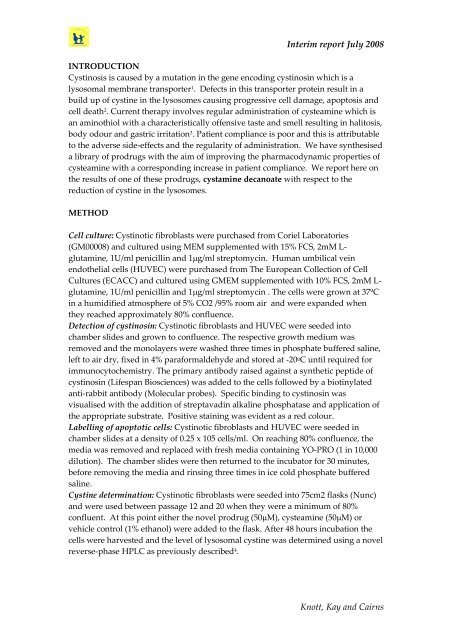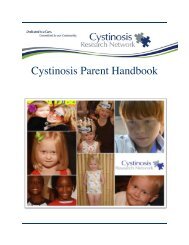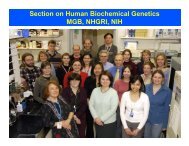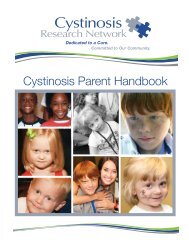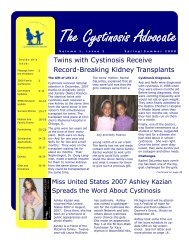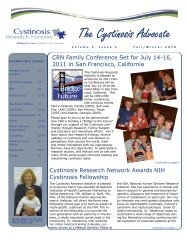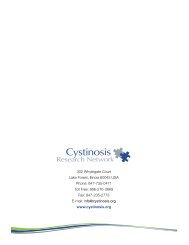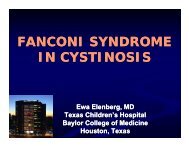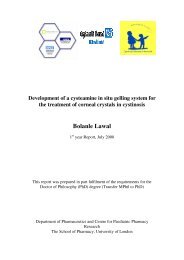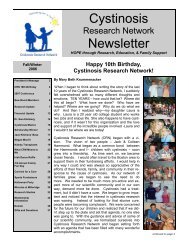Evaluation of Novel Prodrugs for the Treatment of Nephropathic ...
Evaluation of Novel Prodrugs for the Treatment of Nephropathic ...
Evaluation of Novel Prodrugs for the Treatment of Nephropathic ...
You also want an ePaper? Increase the reach of your titles
YUMPU automatically turns print PDFs into web optimized ePapers that Google loves.
Interim report July 2008<br />
INTRODUCTION<br />
Cystinosis is caused by a mutation in <strong>the</strong> gene encoding cystinosin which is a<br />
lysosomal membrane transporter 1 . Defects in this transporter protein result in a<br />
build up <strong>of</strong> cystine in <strong>the</strong> lysosomes causing progressive cell damage, apoptosis and<br />
cell death 2 . Current <strong>the</strong>rapy involves regular administration <strong>of</strong> cysteamine which is<br />
an aminothiol with a characteristically <strong>of</strong>fensive taste and smell resulting in halitosis,<br />
body odour and gastric irritation 3 . Patient compliance is poor and this is attributable<br />
to <strong>the</strong> adverse side-effects and <strong>the</strong> regularity <strong>of</strong> administration. We have syn<strong>the</strong>sised<br />
a library <strong>of</strong> prodrugs with <strong>the</strong> aim <strong>of</strong> improving <strong>the</strong> pharmacodynamic properties <strong>of</strong><br />
cysteamine with a corresponding increase in patient compliance. We report here on<br />
<strong>the</strong> results <strong>of</strong> one <strong>of</strong> <strong>the</strong>se prodrugs, cystamine decanoate with respect to <strong>the</strong><br />
reduction <strong>of</strong> cystine in <strong>the</strong> lysosomes.<br />
METHOD<br />
Cell culture: Cystinotic fibroblasts were purchased from Coriel Laboratories<br />
(GM00008) and cultured using MEM supplemented with 15% FCS, 2mM L-<br />
glutamine, 1U/ml penicillin and 1g/ml streptomycin. Human umbilical vein<br />
endo<strong>the</strong>lial cells (HUVEC) were purchased from The European Collection <strong>of</strong> Cell<br />
Cultures (ECACC) and cultured using GMEM supplemented with 10% FCS, 2mM L-<br />
glutamine, 1U/ml penicillin and 1g/ml streptomycin . The cells were grown at 37ºC<br />
in a humidified atmosphere <strong>of</strong> 5% CO2 /95% room air and were expanded when<br />
<strong>the</strong>y reached approximately 80% confluence.<br />
Detection <strong>of</strong> cystinosin: Cystinotic fibroblasts and HUVEC were seeded into<br />
chamber slides and grown to confluence. The respective growth medium was<br />
removed and <strong>the</strong> monolayers were washed three times in phosphate buffered saline,<br />
left to air dry, fixed in 4% para<strong>for</strong>maldehyde and stored at -20 o C until required <strong>for</strong><br />
immunocytochemistry. The primary antibody raised against a syn<strong>the</strong>tic peptide <strong>of</strong><br />
cystinosin (Lifespan Biosciences) was added to <strong>the</strong> cells followed by a biotinylated<br />
anti-rabbit antibody (Molecular probes). Specific binding to cystinosin was<br />
visualised with <strong>the</strong> addition <strong>of</strong> streptavadin alkaline phosphatase and application <strong>of</strong><br />
<strong>the</strong> appropriate substrate. Positive staining was evident as a red colour.<br />
Labelling <strong>of</strong> apoptotic cells: Cystinotic fibroblasts and HUVEC were seeded in<br />
chamber slides at a density <strong>of</strong> 0.25 x 105 cells/ml. On reaching 80% confluence, <strong>the</strong><br />
media was removed and replaced with fresh media containing YO-PRO (1 in 10,000<br />
dilution). The chamber slides were <strong>the</strong>n returned to <strong>the</strong> incubator <strong>for</strong> 30 minutes,<br />
be<strong>for</strong>e removing <strong>the</strong> media and rinsing three times in ice cold phosphate buffered<br />
saline.<br />
Cystine determination: Cystinotic fibroblasts were seeded into 75cm2 flasks (Nunc)<br />
and were used between passage 12 and 20 when <strong>the</strong>y were a minimum <strong>of</strong> 80%<br />
confluent. At this point ei<strong>the</strong>r <strong>the</strong> novel prodrug (50M), cysteamine (50M) or<br />
vehicle control (1% ethanol) were added to <strong>the</strong> flask. After 48 hours incubation <strong>the</strong><br />
cells were harvested and <strong>the</strong> level <strong>of</strong> lysosomal cystine was determined using a novel<br />
reverse-phase HPLC as previously described 4 .<br />
Knott, Kay and Cairns


